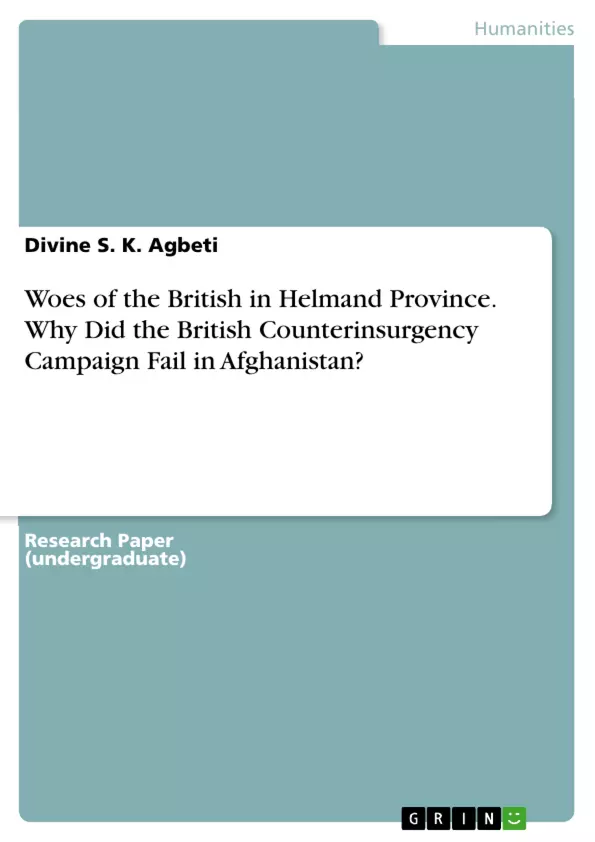At the heart of British counterinsurgency strategy is the “hearts and minds” (HAM) campaign which seeks to create space to advance political solutions leading to peace and stability. However, British strategy, embedded in the Joint UK Plan for Afghanistan, failed to win “hearts and minds” in Afghanistan and can be seen to have failed.
This article defines failure as the inability to set the conditions for “fostering the political process, establishing security, and stimulating economic development”. It seeks to analyse what went wrong: examining strategy, application of COIN principles, context and resources. The paper contends that the principles outlined by Robert Thompson (1966) are a prerequisite to the execution of a successful COIN. The paper asks: did COIN fail through a departure from Thompson’s principles, or under-resourcing, or the political context in Afghanistan, or the impact of US and NATO roles, or all of these factors.
After a thorough investigation the findings are clear: Although the Joint UK Plan for Afghanistan adopted Thompson’s principles, the study has revealed complete departure from those classical principles, causing challenges for the British COIN. The study has also demonstrated that the British failed to win HAM in Helmand because they could not provide security to advance political solutions leading to peace and stability due to tactical mistakes, limited resources, incompetence of Karzai’s government and ethnic undercurrents, the US counterterrorism mission, and the relationship between the Taliban and Pakistan.
The British were demonstrably under-prepared, under-resourced, and lacked a clear and achievable strategy to deliver COIN success in Afghanistan. These factors indicate a departure from Thompson’s principles, leading to a complete failure in Afghanistan.
Inhaltsverzeichnis (Table of Contents)
- Abstract
- Introduction
- Defining Insurgency
- The concept of Counterinsurgency
- Classical and Neo-Classical Approaches to COIN
- The British Plan for Helmand
- Examining Strategy and Intelligence
- Limited Resources
- Post-Bonn Political Context and Ethnicity
- NATO COIN strategy and US counterterrorism policy
- The relationship between the Taliban and Pakistan
- Conclusion
Zielsetzung und Themenschwerpunkte (Objectives and Key Themes)
This article examines the challenges faced by the British Counterinsurgency Campaign in Afghanistan, specifically focusing on the Helmand Province. It aims to analyze the reasons for the campaign's failure, examining strategic decisions, the application of COIN principles, the political context, and the availability of resources.
- The importance of “hearts and minds” (HAM) in COIN operations
- The effectiveness of Robert Thompson's classical COIN principles
- The impact of limited resources and strategic blunders
- The role of political corruption and ethnic undercurrents
- The complexities of US counterterrorism policy and Pakistan's support for the Taliban
Zusammenfassung der Kapitel (Chapter Summaries)
- Abstract: This chapter defines the concept of COIN and outlines the main themes and arguments of the article.
- Introduction: This chapter presents the context of the British COIN campaign in Afghanistan and introduces the core research questions addressed in the article.
- Defining Insurgency: This chapter provides a definition of insurgency and discusses its characteristics, drawing on insights from various scholars and military manuals.
- The concept of Counterinsurgency: This chapter explores the concept of COIN, emphasizing the importance of winning over the civilian population and examining the key principles of the "hearts and minds" approach.
- Classical and Neo-Classical Approaches to COIN: This chapter evaluates the contrasting perspectives of classical and neo-classical COIN theories, comparing the principles laid out by Robert Thompson with the evolving nature of contemporary insurgencies.
- The British Plan for Helmand: This chapter outlines the British strategic plan for Helmand, emphasizing the adoption of Thompson's principles and the envisioned "clear-hold-build" approach.
- Examining Strategy and Intelligence: This chapter analyzes the complexities of the British mission in Helmand, highlighting the conflicting goals of counterterrorism and COIN, and the lack of accurate intelligence on the Taliban's strength.
- Limited Resources: This chapter explores the challenges posed by limited resources, particularly the insufficient troop numbers deployed in Helmand, and the resulting strategic compromises and tactical mistakes.
- Post-Bonn Political Context and Ethnicity: This chapter examines the impact of political corruption and ethnic divisions in Afghanistan on the British COIN campaign, highlighting the role of Karzai's government and the Pashtun population in Helmand.
- NATO COIN strategy and US counterterrorism policy: This chapter analyzes the impact of the US-led counterterrorism mission on the British COIN efforts, emphasizing the contrasting goals and approaches of both strategies.
- The relationship between the Taliban and Pakistan: This chapter explores the challenges posed by Pakistan's support for the Taliban, highlighting the strategic interests and historical ties that hinder the success of the British COIN campaign.
Schlüsselwörter (Keywords)
This article focuses on the British counterinsurgency campaign in Helmand, Afghanistan, examining the challenges faced by the British forces in winning the "hearts and minds" of the local population. The article analyzes the effectiveness of classical COIN principles, the impact of limited resources, and the influence of political corruption, ethnic divisions, US counterterrorism policy, and Pakistan's support for the Taliban. Key themes explored include counterinsurgency theory, strategic blunders, resource constraints, and the complexities of the political and social landscape in Afghanistan.
- Quote paper
- Divine S. K. Agbeti (Author), 2015, Woes of the British in Helmand Province. Why Did the British Counterinsurgency Campaign Fail in Afghanistan?, Munich, GRIN Verlag, https://www.hausarbeiten.de/document/304531


